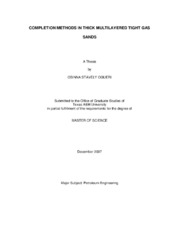| dc.description.abstract | Tight gas sands, coal-bed methane, and gas shales are commonly called
unconventional reservoirs. Tight gas sands (TGS) are often described as
formations with an expected average permeability of 0.1mD or less. Gas
production rates from TGS reservoirs are usually low due to poor permeability.
As such, state-of-the-art technology must be used to economically develop the
resource. TGS formations need to be hydraulically fractured in order to enhance
the gas production rates. A majority of these reservoirs can be described as
thick, multilayered gas systems. Many reservoirs are hundreds of feet thick and
some are thousands of feet thick. The technology used to complete and
stimulate thick, tight gas reservoirs is quite complex. It is often difficult to
determine the optimum completion and stimulating techniques in thick reservoirs.
The optimum methods are functions of many parameters, such as depth,
pressure, temperature, in-situ stress and the number of layers. In multilayered
reservoirs, it is important to include several sand layers in a single completion. The petroleum literature contains information on the various diversion
techniques involved in the completion of these multilayered reservoirs.
In this research, we have deduced and evaluated eight possible
techniques that have been used in the oil and gas industry to divert multilayered
fracture treatments in layered reservoirs. We have developed decision charts,
economic analyses and computer programs that will assist completion engineers
in determining which of the diversion methods are feasible for a given well
stimulation. Our computer programs have been tested using case histories from
the petroleum literature with results expressed in this thesis. A limited entry
design program has also being developed from this research to calculate the
fluid distribution into different layers when fracture treating multilayered tight gas
reservoirs using the limited entry technique.
The research is aimed at providing decision tools which will eventually be
input into an expert advisor for well completions in tight gas reservoirs worldwide. | en |


